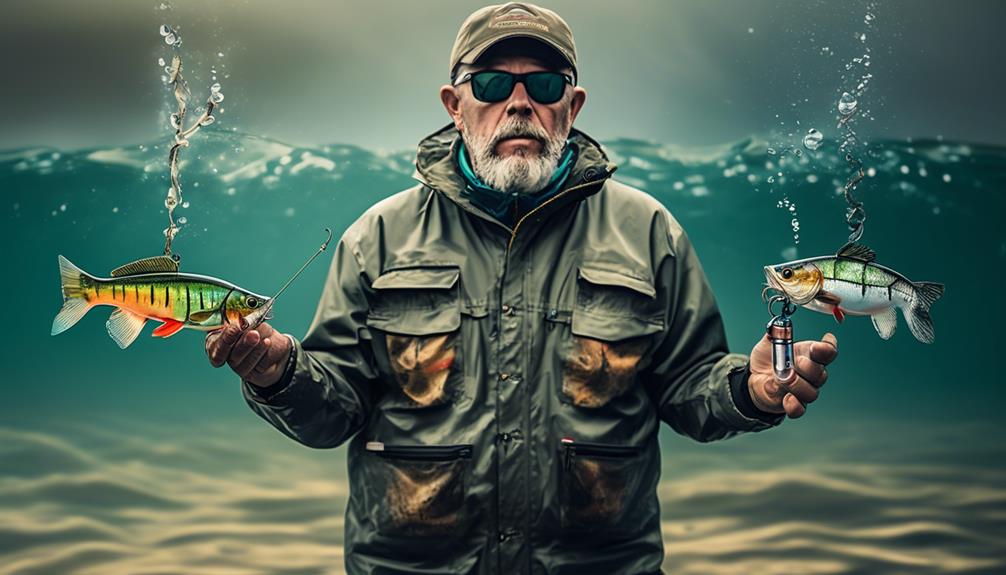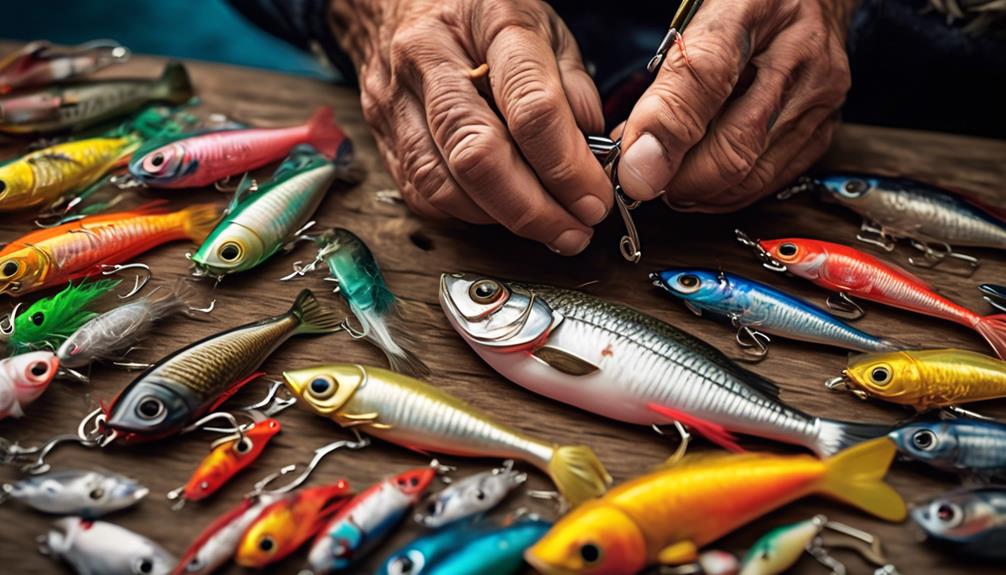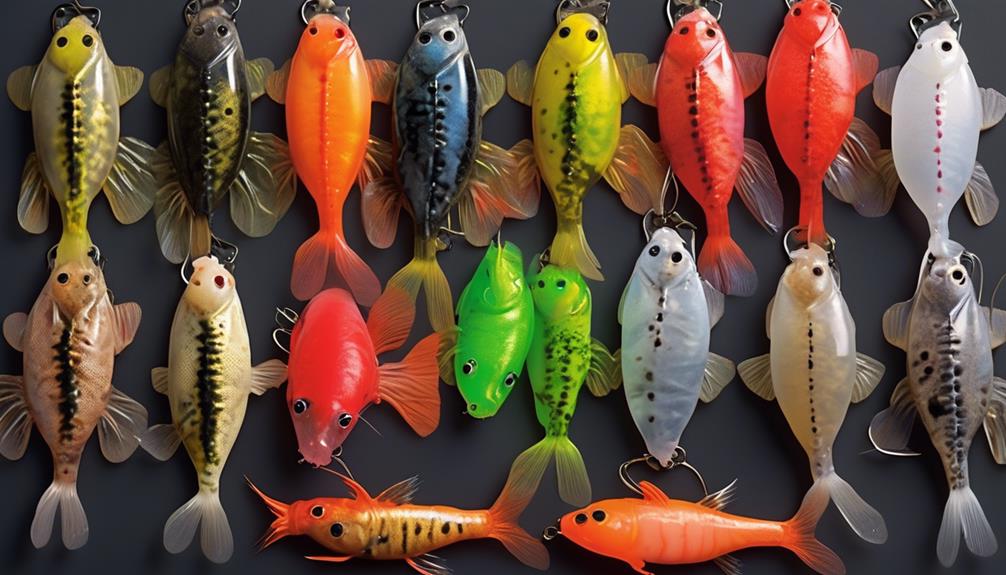Just like choosing the right tool for the job, selecting the appropriate lure for different times of day can significantly impact your fishing experience.
From the soft light of early morning to the murky depths of night, the conditions and behaviors of fish change, and so should your lure choice.
But why does it matter?
Well, as you'll soon discover, the type of lure you use can make all the difference between a successful catch and a day of frustration.
Morning Fishing
When fishing in the morning, selecting the right lure can significantly impact your chances of catching fish. The sunrise bite is a critical time for anglers, and understanding bait selection is key to maximizing your success.
During the early morning topwater action, it's essential to choose the right lure color to entice the fish. As the sun begins to rise, the fish become more active, making it an ideal time to use topwater lures. These lures create a commotion on the water's surface, mimicking prey that's easy for the fish to spot in the low light. Opt for lures in natural colors like white, silver, or frog patterns during this time. These colors stand out against the water and are more visible to the fish during the early morning light.
When it comes to bait selection, consider the feeding habits of the fish in the morning. They're often seeking smaller prey near the water's surface. Therefore, using lures that imitate insects, small fish, or frogs can be highly effective. Additionally, lures with rattles or propellers can create extra noise and movement, further attracting the fish during the sunrise bite.
Midday Sun
During the midday sun, the fishing conditions become more challenging as the fish seek shelter in deeper waters or shaded areas. The heat index rises, making it uncomfortable for both fish and anglers. As the sun reaches its zenith, the solar angle is high, resulting in more direct and intense sunlight. This causes surface water temperatures to increase, leading fish to retreat to cooler, deeper waters. Shaded areas such as docks, overhanging trees, or structures provide relief from the heat and become prime spots for fish to seek refuge.
When the heat index climbs, fish tend to become lethargic, reducing their activity and willingness to chase down fast-moving lures. As a result, it becomes crucial to adjust your lure choice during this time. Opt for slower-moving lures such as soft plastics, jigs, or slow-rolling spinnerbaits. These lures present a more tempting and less strenuous target for the fish in the midday heat.
Understanding the impact of the midday sun on fish behavior and adjusting your fishing approach accordingly is essential for a successful fishing trip. By focusing on deeper waters and shaded areas and adapting to the fish's decreased activity level, you can improve your chances of a productive catch during the challenging midday conditions.
Afternoon Shadows
In the afternoon shadows, your lure choice can play a crucial role in enticing fish to bite as the changing light conditions affect their behavior. As the sun starts to descend, it creates a stunning visual effect on the water, casting long shadows and creating unique sunset patterns.
During this time, the evening bite begins, and fish become more active as they prepare for the night ahead. It's essential to consider the impact of these transitioning light conditions on the fish's behavior and adjust your lure choice accordingly.
The decreasing light levels during the afternoon shadows can trigger a feeding frenzy among fish. They become more aggressive and start actively hunting for prey. This is where selecting lures that mimic the movements of baitfish can be highly effective. Crankbaits and swimbaits that imitate the erratic swimming patterns of panicked baitfish can capitalize on the increased activity of game fish during this time. Additionally, topwater lures that create disturbances on the surface can attract fish that are seeking an easy meal in the low light conditions.
As the sun sets and the shadows lengthen, fish tend to move closer to the surface to feed, making it an opportune time to use topwater lures. The changing light also affects the visibility of lures, so choosing ones with contrasting colors that stand out in the dimming light can significantly improve your chances of enticing a strike.
Being mindful of these evening bite behaviors and sunset patterns can give you an edge in catching fish during the afternoon shadows.
Dusk and Dawn
At dusk and dawn, your lure choice can greatly impact your success in catching fish as the changing light conditions trigger shifts in their feeding behavior. During these times, the low light and changing conditions prompt fish to move into shallower waters to feed. This makes it crucial to select lures that are highly visible and create strong vibrations to attract the attention of the fish.
With the diminishing light at dusk, fish become more active, seeking out their last meal before nightfall. This is when using lures that produce a lot of noise or have bright colors can be highly effective. Topwater lures like poppers or buzzbaits can create commotion on the surface, drawing fish in to investigate. Additionally, lures with reflective or fluorescent qualities can stand out in the fading light, increasing their visibility to the fish.
Similarly, at dawn, as the light begins to increase, fish are also on the hunt for food. The changing conditions from darkness to light can make fish more aggressive in their feeding. This is a great time to use lures that mimic injured baitfish, such as jerkbaits or swimbaits. These lures can capitalize on the fish's heightened activity during the transition from low light to daylight.
Cloudy Conditions
When faced with cloudy conditions, opt for lures that offer high contrast and strong silhouette to enhance their visibility to the fish. In cloudy weather, the natural light is diffused, making it harder for fish to distinguish details and colors. Therefore, using lures with vibrant and contrasting colors such as chartreuse, orange, or red can make them more visible to fish in murky waters. These colors stand out against the overcast sky and dark water, increasing the likelihood of attracting bites.
Additionally, consider adjusting your retrieval speed when using lures in cloudy conditions. Slower retrieval speeds can be more effective as fish may be less active in low light situations. This slower presentation allows fish more time to locate and strike the lure. However, it's essential to experiment with different retrieval speeds to gauge the fish's response and determine the most effective approach.
It's also important to note that while high-contrast colors can be effective in cloudy conditions, it's not a one-size-fits-all solution. The effectiveness of lure color and retrieval speed can vary based on factors such as water clarity, the species of fish targeted, and the specific weather conditions. Therefore, it's crucial to adapt and be willing to test different lure colors and retrieval speeds to find the most successful combination for the given cloudy conditions.
Night Fishing
Consider adjusting your lure selection for night fishing to capitalize on the low light conditions and the fish's heightened reliance on sensory cues. When fishing at night, the moon phases play a crucial role in determining the feeding patterns of fish.
During a full moon, the increased light can make fish more active and visible, so using lures that create more vibration or disturbance in the water, like noisy topwater lures, can be effective. Conversely, during a new moon, when light is minimal, using lures with contrasting colors or those that reflect light can attract fish.
Bait selection is also crucial for night fishing. Since fish rely heavily on their senses in low-light conditions, using bait with strong scents or those that create a lot of movement can lead to successful catches. Consider using live bait such as minnows or leeches, which can give off strong scents and movement, or artificial baits like soft plastic lures with paddle tails that create enticing movements in the water.
Artificial lighting can also be used to attract fish during night fishing. Nocturnal feeding habits often involve fish seeking out areas with artificial light, as it can attract smaller baitfish and insects, which in turn draw in larger predatory fish. Utilizing submersible fishing lights can help attract fish to your location, increasing your chances of a successful night fishing trip.
Adjusting your lure selection and being mindful of moon phases, bait selection, and artificial lighting can significantly improve your night fishing experience.
Seasonal Changes

Adjust your lure selection to account for seasonal changes, as fish behavior and feeding patterns vary throughout the year.
Understanding the impact of seasonal changes on fish behavior is crucial for successful fishing. In spring, fish are more active and tend to move into shallow waters for spawning. This is a great time to use lures that mimic small baitfish or insects, such as spinnerbaits, soft plastic worms, or topwater lures. These lures will entice the fish as they're actively feeding and looking for food to replenish their energy after winter.
On the other hand, fall patterns bring about changes in fish behavior as they start preparing for the upcoming winter. During this time, fish feed more voraciously to store energy for the colder months. Using lures that imitate dying baitfish, such as crankbaits, jerkbaits, or jigs, can be highly effective during this season. These lures capitalize on the fish's instinct to feed aggressively in preparation for winter, increasing your chances of a successful catch.
Water Clarity
To maximize your fishing success, it's essential to understand how water clarity impacts lure choice and adjust accordingly.
Water clarity plays a significant role in determining the most effective lure color and size for fishing. In clear water, natural and realistic lure colors such as greens, browns, and shad patterns tend to work best. The transparency of the water allows fish to see the details of the lure, so it's crucial to use colors that mimic the natural prey of the fish in that specific environment. Additionally, in clear water, smaller lures often yield better results as they appear more natural and less obtrusive.
Conversely, in murky or stained water, brighter and more vibrant colors like chartreuse, orange, and pink can be more effective as they provide better visibility in low light conditions. The reduced visibility in murky water makes it essential to use colors that stand out and grab the attention of the fish. Furthermore, in these conditions, larger lures are often preferred as they create more disturbance and are easier for fish to locate.
Understanding the impact of water clarity on lure color and size is crucial for adapting your fishing approach. By choosing the right lure colors and sizes based on the water clarity, you can significantly increase your chances of enticing fish to bite.
Frequently Asked Questions
How Does Lure Choice Differ Between Fishing in a River and Fishing in a Lake?
When fishing in a river, lure selection and angling techniques need to account for the faster currents and varied depths. River fishing often requires smaller lures that can move swiftly.
In a lake, the focus shifts to covering a wider area and adapting to different structures. Lakes may call for larger, more visible lures to attract fish in open waters.
Adapting your lure choice to the specific conditions of each location is crucial for success.
What Are the Best Lures to Use When Targeting Specific Species of Fish, Such as Bass or Trout?
When targeting specific species like bass or trout, there are several factors to consider. Color selection, depth range, retrieval speed, and bait size all play a crucial role.
For bass, it is recommended to use crankbaits or soft plastic worms in natural colors. These imitate the natural prey of bass and increase the chances of attracting them.
On the other hand, trout are attracted to smaller spinners or spoons with more vibrant color patterns. These lures mimic the movement and appearance of trout's favorite food sources, such as insects or small fish.
How Does Water Temperature Affect Lure Choice, and What Lures Work Best in Warmer or Colder Water?
When it comes to water temperature, lure choice is crucial.
Warmer water calls for bright colors and lures with visual appeal, while colder water requires more subdued colors.
Sinking vs. floating lures matter too; in warmer water, fish tend to be deeper, so sinking lures are effective.
In colder water, floating lures can stay in the strike zone longer.
Understanding these factors helps you adapt to changing conditions and catch more fish.
Are There Any Specific Techniques or Retrieves That Work Best With Certain Types of Lures During Different Times of Day?
During morning fishing, focus on depth control and use lures that mimic natural prey movements.
As the day progresses, adjust lure presentation to match changing conditions.
For night fishing, opt for lures that create vibration and sound to attract fish in low light.
Vary your retrieval speed and experiment with different lure actions to find what works best during different times of day.
How Do Environmental Factors Like Wind and Current Affect Lure Choice, and How Can Anglers Adjust Their Tactics Accordingly?
When fishing, wind speed and current direction impact lure choice. Adjust your tactics based on these environmental factors.
Lures that mimic natural prey movement are effective in strong currents, while in windy conditions, consider using heavier lures for better control.
Pay attention to how these factors affect the behavior of baitfish and adjust your lure choice accordingly.
Adapting to wind and current will increase your chances of a successful catch.
Conclusion
So, next time you head out for a day of fishing, remember that the choice of lure can make all the difference.
Pay attention to the time of day, weather conditions, and water clarity to select the right lure for the job.
By being mindful of these factors, you can increase your chances of a successful catch and have a more enjoyable fishing experience overall.
Happy fishing!



